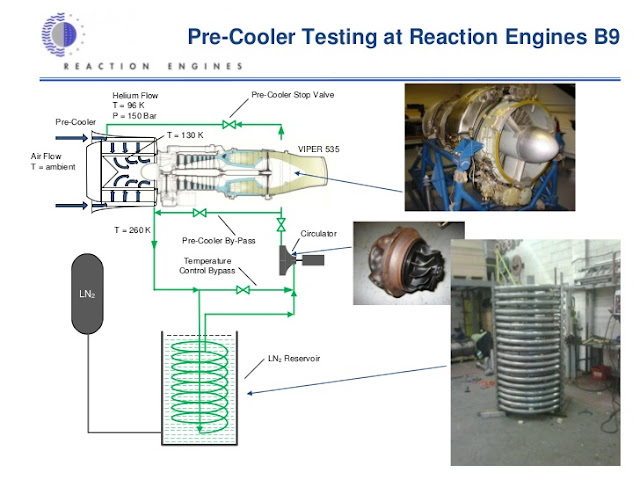Leading development of hypersonic engines and spaceplanes
by noreply@blogger.com (brian wang) from NextBigFuture.com on (#2C1PK)
The leading projects for developing a hypersonic spaceplane are Reaction Engines of the UK and Hypermach.
Reaction Engines Skylon
Reaction Engines of the UK is a leader in developing a hypersonic vehicle and hypersonic components. The British government finalized a 60 million to the project: this investment will provide support at a "crucial stage" to allow a full-scale prototype of the SABRE engine to be built. If all goes to plan, the first ground-based engine tests could happen in 2019, and Skylon could be performing unmanned test flights by 2025. In November 2015, BAE Systems invested 20.6 million in Reaction Engines to acquire 20 per cent of its share capital and agreed to provide industrial, technology development and project management expertise to support Reaction Engines during its development phase. It could carry 15 tonnes of cargo to a 300 km equatorial orbit on each trip, and up to 11 tonnes to the International Space Station, almost 45% more than the capacity of the European Space Agency's ATV vehicle.



Full Skylon spaceplane development is estimated to be in the $12 billion range.
The US Air Force Research Lab has studied the Skylon design and concepts and is interested
Hypermach Hyperstar Mach 5
HyperMach has designs for a Mach 5 hypersonic passenger plane that would travel at 80,000 feet and have 7,000-nm range. They are busy developing and testing the critical technology built into the SSBJ's 76,000-pound-thrust H-Magjet 5500-X hybrid turbofan ramjet engines. Lugg said the company holds "major patents" for its "revolutionary propulsion technology," which includes a superconducting turbo power core ring to generate the aircraft's high electrical power requirements.
Hypermach has completed final detail design of the first stage turbine core of a hypersonic engine. Manufacturing of this first stage has begun and is expected to be finished in 2016, with testing on the rig as early as February 2017. All five stages will be completed through 2018, with complete turbine core test in the fourth quarter of 2018.
A full engine run is scheduled for 2019, and Lugg said that his company has spent the last year working with new industry partners and hiring team members for the superconducting turbine core.
First flight of the HyperStar is now expected in 2025, with certification and entry into service slated to follow in 2028, he said. Both estimates are three years later than what was announced previously.
If demos are successful then funding would flow from the US military to develop hypersonic military fighter and spy planes.

Read more










Reaction Engines Skylon
Reaction Engines of the UK is a leader in developing a hypersonic vehicle and hypersonic components. The British government finalized a 60 million to the project: this investment will provide support at a "crucial stage" to allow a full-scale prototype of the SABRE engine to be built. If all goes to plan, the first ground-based engine tests could happen in 2019, and Skylon could be performing unmanned test flights by 2025. In November 2015, BAE Systems invested 20.6 million in Reaction Engines to acquire 20 per cent of its share capital and agreed to provide industrial, technology development and project management expertise to support Reaction Engines during its development phase. It could carry 15 tonnes of cargo to a 300 km equatorial orbit on each trip, and up to 11 tonnes to the International Space Station, almost 45% more than the capacity of the European Space Agency's ATV vehicle.



Full Skylon spaceplane development is estimated to be in the $12 billion range.
The US Air Force Research Lab has studied the Skylon design and concepts and is interested
Hypermach Hyperstar Mach 5
HyperMach has designs for a Mach 5 hypersonic passenger plane that would travel at 80,000 feet and have 7,000-nm range. They are busy developing and testing the critical technology built into the SSBJ's 76,000-pound-thrust H-Magjet 5500-X hybrid turbofan ramjet engines. Lugg said the company holds "major patents" for its "revolutionary propulsion technology," which includes a superconducting turbo power core ring to generate the aircraft's high electrical power requirements.
Hypermach has completed final detail design of the first stage turbine core of a hypersonic engine. Manufacturing of this first stage has begun and is expected to be finished in 2016, with testing on the rig as early as February 2017. All five stages will be completed through 2018, with complete turbine core test in the fourth quarter of 2018.
A full engine run is scheduled for 2019, and Lugg said that his company has spent the last year working with new industry partners and hiring team members for the superconducting turbine core.
First flight of the HyperStar is now expected in 2025, with certification and entry into service slated to follow in 2028, he said. Both estimates are three years later than what was announced previously.
If demos are successful then funding would flow from the US military to develop hypersonic military fighter and spy planes.

Read more